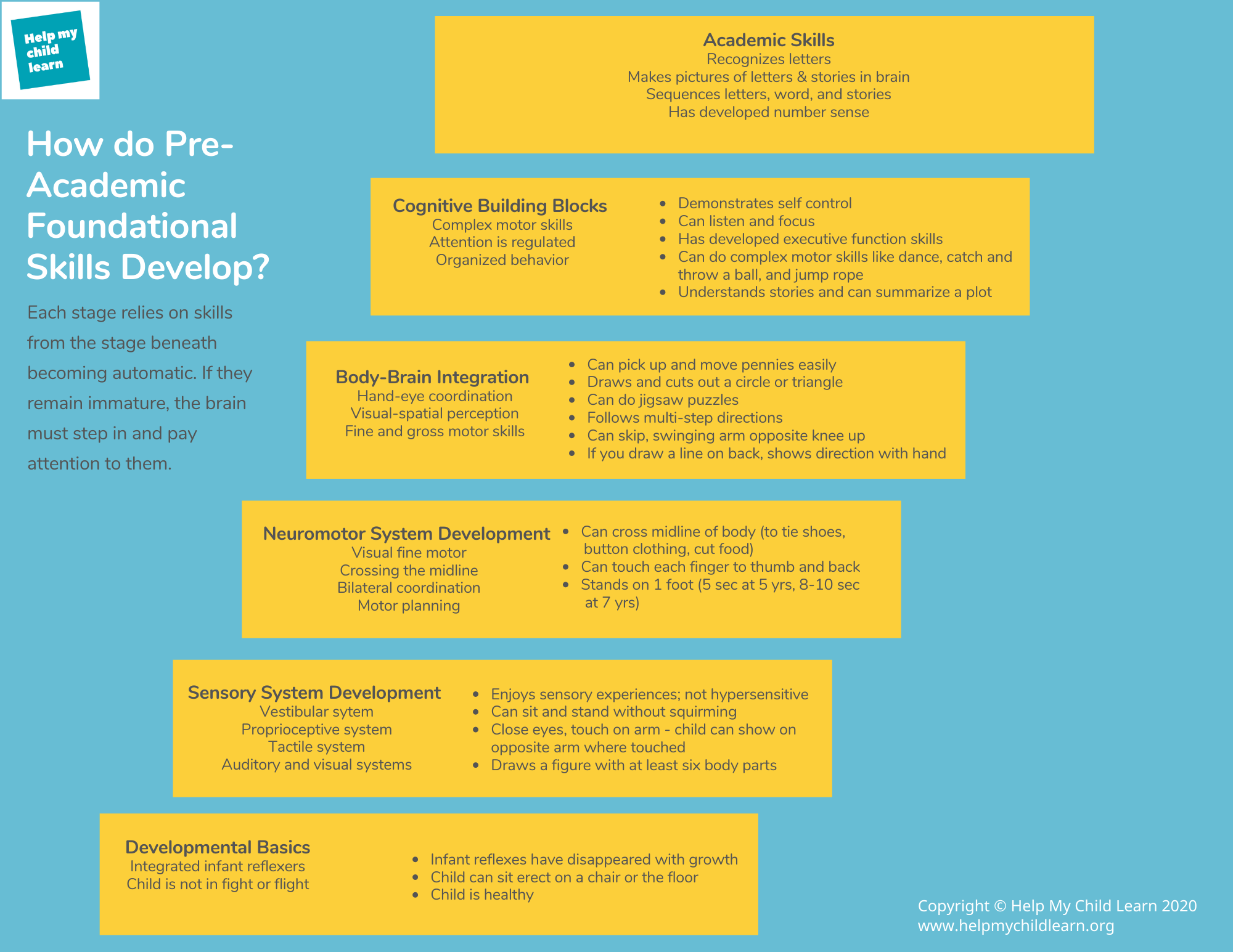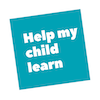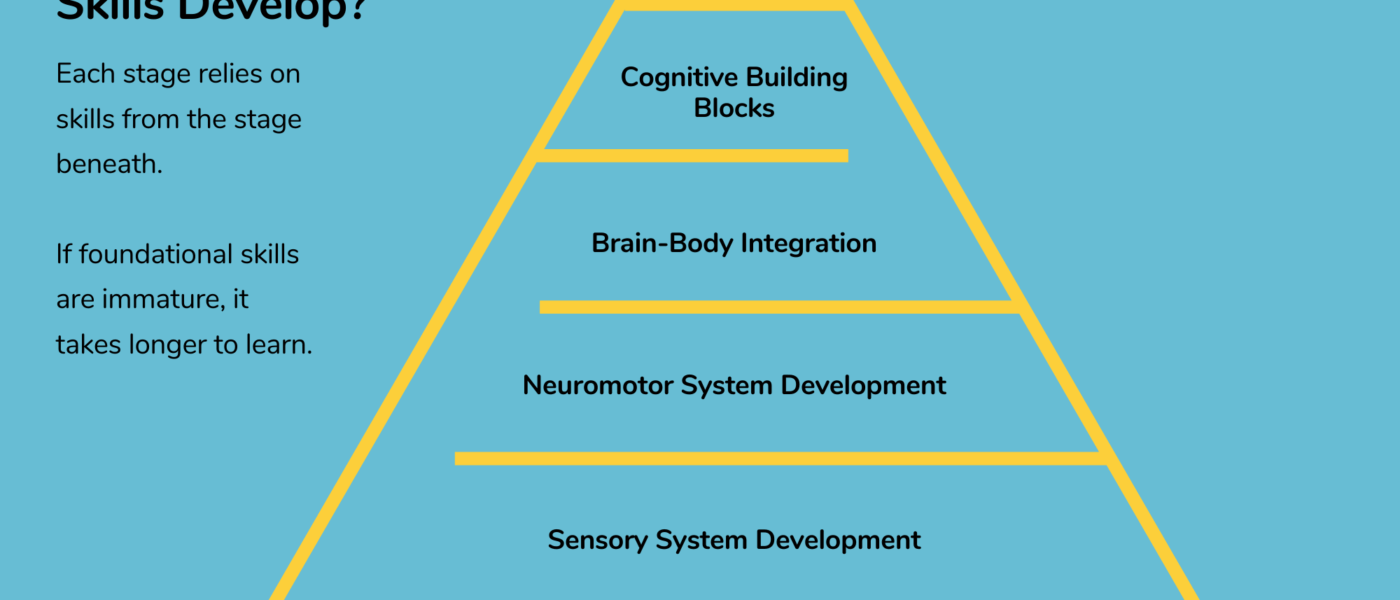Developing Foundational Skills
Supporting children with learning disabilities is nuanced, and depends on the individual child’s abilities. One of the important things that parents need to learn about is brain maturity and foundational skills, which often are very difficult for LD children to learn, but are often overlooked.
This section gives you information about learning differences and brain maturity that it often takes years for parents to discover.
Foundational Skills and Brain Development
Thirty years ago in the UK, according to Sally Goddard Blythe, director of the UK’s Institute for Neuro-Physiological Psychology (INPP), every child was given a physical assessment by a doctor when they started school. They were asked to do simple physical tasks such as stand on one leg, hop to the end of the room and back, and pile some bricks; they also had their sight and hearing tested. The movement test helped to determine whether a child was ready for school. Blythe maintains that schools dropped the old-fashioned movement test because they didn’t know what to do with the kids who didn’t pass. Most schools still don’t test movement.
Every year at the doctor’s office, your child’s movements are tested as part of regular milestone checkups. If your child looks as though everything is normal, however a doctor will often only check a few physical milestones. Here’s a description of milestones from Kindergarten, through third grade. It’s normal for children to be late on a milestone or two, but looking back, many LD parents realize that their child had a pattern of problems with milestones.
In the year or so before starting Kindergarten, it’s good to know which milestone abilities act as foundational skills, or pre-academic skills. Since skipped or late foundational skills can make it harder to learn, it’s a good time to practice movement.
Foundational skills often indicate that the brain no longer needs to consciously control and monitor the body. This “mind free” stage means that the brain is able to focus on learning academic skills — instead of focusing on keeping upright or sitting still. Foundational skills provide structural support for higher-level thought.
Mary Scholer is an occupational therapist and Executive Director of the Simoneon Pediatric Development Center in San Jose. With over 35 years of experience and training, Mary understands foundational skills and how to develop them. She says that:
It’s harder to develop academic skills if a child has immature physical, sensory, and motor development.
Children with learning differences very often have sensory and motor development that isn’t in sync, or is late to develop. Many parents report seeing late motor development through grade school and sometimes older. LD children can have a lot of problems with foundational skills for school, including sitting at a chair, to listening, copying from the board, focus, attention, and memory.
Why Are Foundational Skills Important?
Schools often just assume that children have mature foundational skills. But immature foundational skills can determine whether a child is successful or fails at early academics. Often, tutors and therapists will focus on developing foundational skills, but they don’t use this term, and parents often don’t understand what they’re trying to do.
Here’s what happened to Jane and her son, Kyler. In Kindergarten, Kyler had very poor handwriting. The teacher told Jane that she should practice handwriting at home with Kyler, so they did, for a half-hour a day. Kyler hated it and it didn’t help. Next, Kyler took a handwriting class, which didn’t work either.
It turned out that Kyle had an immature sensory system. When Jane took him to a pediatric occupational therapist, the OT put Kyle on an exercise plan to develop his proprioceptive sense and his brain-body integration. By doing movement exercises, Kyle’s brain became better at controlling his body. After the OT sessions, Kyle found it easier to sit still, and he stopped having as many emotional outbursts.
Later, when Kyle entered a handwriting class with more mature foundational skills, he was able to simply learn to write better.
How do Foundational Skills Develop?

This diagram shows a rough outline of the order in which foundational skills develop, where mature skills are at the top.
You can use this diagram by looking at the top box. Has your child mastered all of these skills? If not, skip to the box beneath, and so forth. Find the lowest box displaying skills that your child finds challenging, and work on those skills first. When your child has mastered the base-level skills, next-level up skills are easier to master. Lower-level skills provide a foundation for higher-level skills.
This diagram is not precise. In reality, the way that skills develop is more complex, but (for example) undeveloped sensory skills can affect perception, which makes it more difficult to master skills that rely on perception.
Many parents don’t understand why a child needs to spend time working on sensory systems (like swinging), when they could be just practicing their math. But basic sensory systems need to fully develop before the brain can focus on academic skills. For some children, it’s more appropriate to spend time on physical work than homework, until the foundational skills are more developed!
Foundational Skills and Movements
Developing Foundational Skills at Home or with Professionals
You can teach and practice all of the foundational skills at home. Here’s a full list of milestones from different sources. Just practicing all of those milestones is a great way to exercise your child’s abilities.
Some children, however, need some extra help learning. One professional who can help develop foundational skills is an occupational therapist (OT). Other professionals include kinesiologists and movement therapists.
Here’s more information about the steps in the diagram:
The bottom step: Developmental Basics. In general, your child should be healthy and settled. By early childhood, your child should be able to sit erect (indicating good core body strength), and the reflexes that a child was born with should have disappeared. Every child is born with a set of reflexes, which are unconsciously connected movements. An example reflex is if you lay your finger on the palm of a newborn, the baby grasps your hand. The baby doesn’t decide to grasp your hand. The baby’s brain just responds to stimulus by closing on the finger. Reflexes are actions that aren’t routed through the thinking brain. They’re just wired in.
When a child’s brain develops normally, the brain integrates infant reflexes, so they disappear, typically by age two. If you lay your finger into the palm of a typical three-year old, you will no longer see the automatic grasp.
Studies say that over 80% of children who have learning disabilities have retained infant reflexes. If you can still measure reflexes in older children, it means that although the brain has developed, it has not fully integrated the reflexes. And many well-established theories say that unintegrated infant reflexes can get in the way of developing foundational skills. One effect of unintegrated reflexes, for example, is toe-walking. Many occupational therapists (OTs), and other movement therapists, use therapy techniques that help infant reflexes integrate — and disappear.
If you think that your child might need help with early development, it’s a good idea to look for a pediatric OT who is trained in reflex integration and will test your child for unintegrated reflexes and offer exercises, because insurance often covers OTs. If you decide to go with a different program, be careful to compare prices and check references.
Sensory System Development Although we were taught as children that we have five senses—sight, hearing touch, taste, and smell—we actually have far more. Some neurologists say that we have nine senses, and others say that we have over 15. Each sense has a sensory brain system, responsible for gathering sense information and getting it understood by the brain.
Dr. Jean Ayres developed the sensory integration theory (now called sensory processing in the 1950’s. In some children, sensory systems develop in an asynchronous fashion, and immature sensory systems can result in children who are at the mercy of their input or the processing of sensory signals. These children often respond to stimulus in an unexpected fashion. Some children are very sensitive to certain types of stimulation, like sound, while others crave stimulation, like movement. Children with sensory processing challenges often have trouble with milestone testing, because their internal senses are either immature or not integrating, or synchronizing. These children are said to have sensory processing disorder, and OTs can provide therapies which help the systems develop and integrate.
Two of the sensory systems that are most significant for school performance are the vestibular system—also called the sense of balance—and the proprioceptive system.
Proprioception comes from the Latin word proprius, meaning “one’s own,” or “individual.” Proprioception is the brain’s ability to know where its body is in space. A simple way to measure proprioceptive development for your child is to have them touch your nose and then their nose. Younger children have troubles finding their body parts in space. They might also have trouble regulating how much effort it takes to move the body: overshooting or not using enough power.
The vestibular system is closely associated with the inner ear, and helps keep the body balanced. It also helps the body develop clear vision and smooth head movements. The vestibular system ties into postural control, eventually allowing the body to unconsciously keep the body upright while dealing with gravity.
When the vestibular and/or proprioceptive senses are immature, the conscious brain must work to keep a child upright and balanced.[xv] When senses are immature, the brain’s energy is focused on controlling the body. Ideally, both senses develop before a child starts school, so that his body operates automatically and his brain can focus on classroom lessons. If a child has immature proprioception and vestibular senses, moving can actually help some children focus. When a child moves his body, his movement sends body location information to the brain, freeing up some brain cycles that can then pay attention. This is one of the reasons why the ability to sit still in a classroom is a developmental step, and why some children pay better attention when squirming or rolling around.
Some lower-grade teachers wrap rubber Theraband™ resistance bands around the front legs of children’s chairs. This allows the children to bounce their legs off of the bands, giving proprioceptive feedback to the brain and allowing the children to sit and focus.
When the senses are fully developed, the child’s movement and body-knowledge is said to be “mind free.” This means that the child’s brain is free to focus on academics, instead of body management.
Sensory Works with Motor Systems (Neuromotor System Development) Your motor systems are a window to your brain maturity. The brain is literally two different pieces. The two sides of the brain are only connected by a small channel called the corpus callosum.
Reaching an arm over to the opposite side of the body is called “crossing the midline.” When a child reaches over their body, signals pass through the corpus callosum, so that both sides of the brain talk with one another. Crossing the midline comes with brain maturity. Many developmental songs and activities involve practicing this gesture, but some children have a difficult time with it.
Crossing the midline is tied to all sorts of tasks like tying shoes and cutting food with knife and fork. Reaching this level of ability is necessary in order to participate in many classroom activities. Some children are not able to draw a large circle with one arm. They need to draw half of the circle, switch arms, and draw the second half of the circle. These children respond well to OT.
If a child constantly slumps and cannot sit upright, chances are that he has some problems with postural control, which is the convergence of several sensory inputs with the motor system. Some OTs report that most of the children they see have challenges with postural control, which can impact ability to stand, sit, focus, and write.
Body-Brain Integration The actions measured in this section indicate that lower-level systems are mature and are working well together. The ability to skip while swinging the opposite leg indicates that the body has developed movement automaticity, which indicates brain maturity. Together with developing handedness (e.g. becoming right- or left-handed), it’s a developmental stage that indicates a child is ready to start school.
Cognitive Building Blocks These are the basic thinking and focus skills.By this step, all of the previous steps have become simple and automatic for the brain. When the brain can perform a series of complex actions in a mind-free fashion, it means that the mind is now available for academic learning. Before this stage, a significant portion of the brain’s energies was taken up consciously monitoring all of the movements mentioned in this diagram — and more.
If your child is having to consciously work to remember where their body is in space and keep their body upright, it makes sense that it’s hard to follow a three-step direction.
It’s easy to support brain development by doing games at home. For example, you can practice standing on one foot with your child. You can play games where your child picks up pennies. Learning that physical activity is important for developing the brain— and why—helps parents choose more active lives for their children.
If your child needs to go to a pediatric occupational therapist, you can ask for exercises to do at home — a good OT will happily provide them. You can also support foundational skill development as you parent, or by engaging your child in sports. Sally Goddard Blythe’s book, Attention, Balance, and Coordination, and Carla Hannaford’s book, Smart Moves, both explain more about foundational skill development and the value of movement in brain development.
It’s a good idea to make sure that your child’s teachers understand that if your child hasn’t yet reached maturity for some of the lower-level foundational skills, schoolwork is much more difficult.




Pingback: The First 6 Things Parents Should Know about Learning Disability - Help My Child Learn
Pingback: Developmental Milestones from Kindergarten to Third Grade - Help My Child Learn
Pingback: Raising an LD Child With the Qualities for Success - Help My Child Learn
Pingback: Why do We Talk About a Pathway to Success? - Help My Child Learn
Pingback: Becoming an Executive Parent for your LD Child - Help My Child Learn
Pingback: How are Your Child's Writing Readiness Skills? - Help My Child Learn
Pingback: Checking Your Child's Reading Readiness Skills - Help My Child Learn